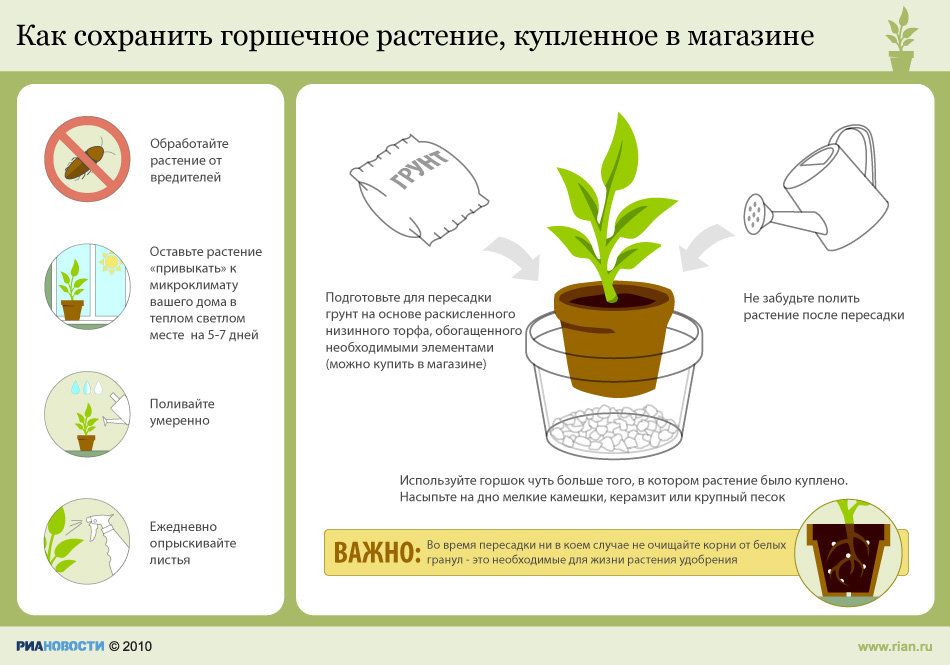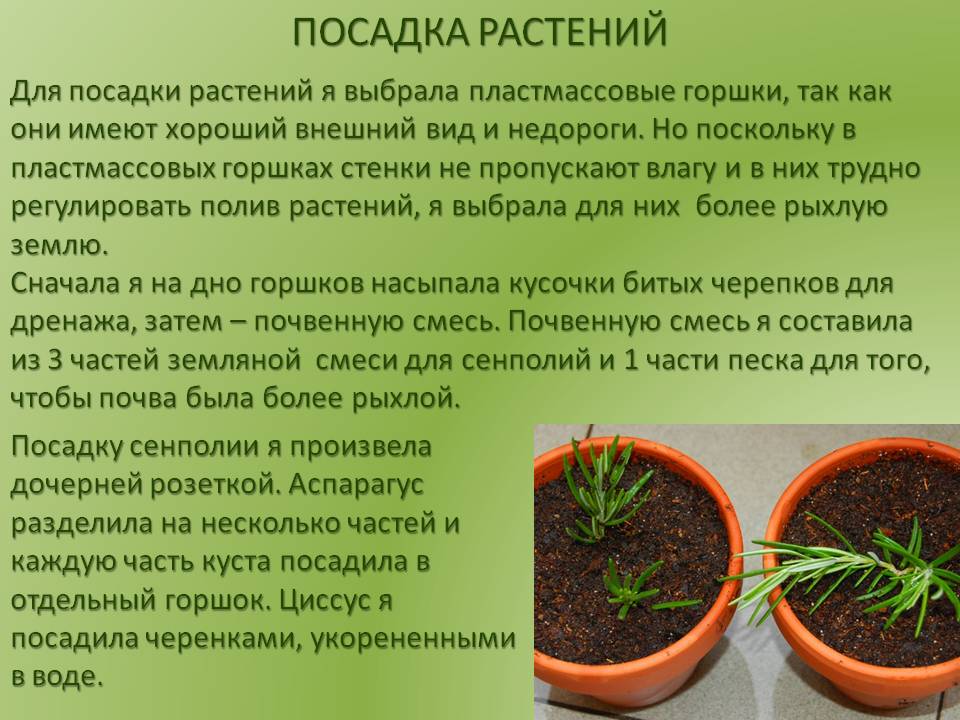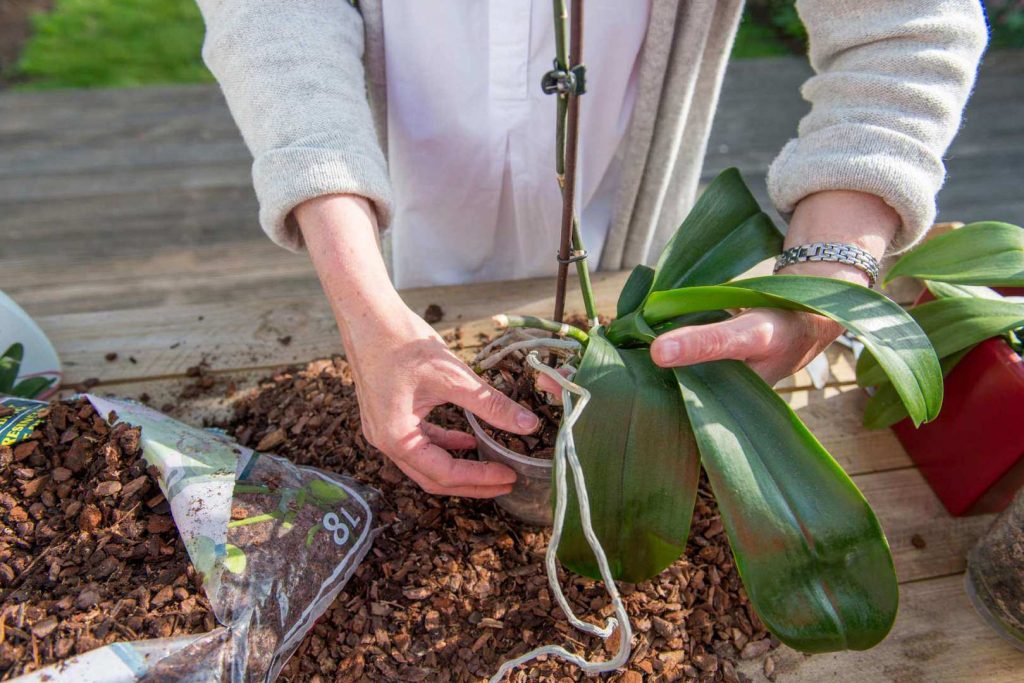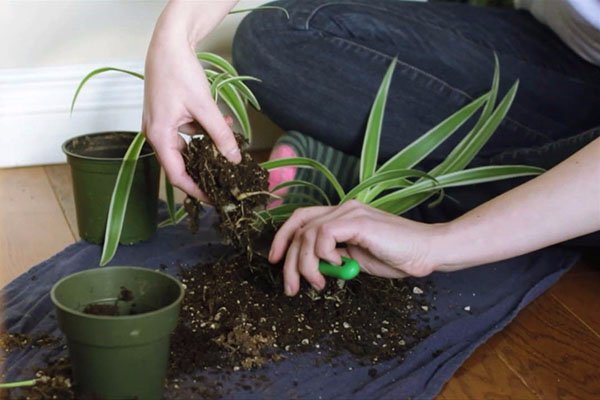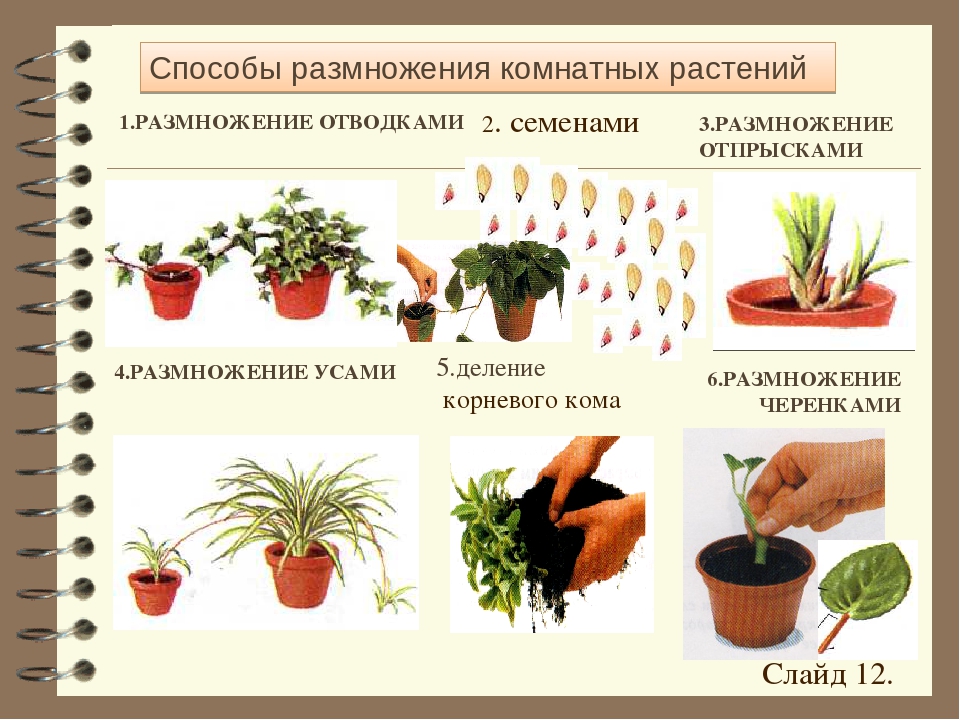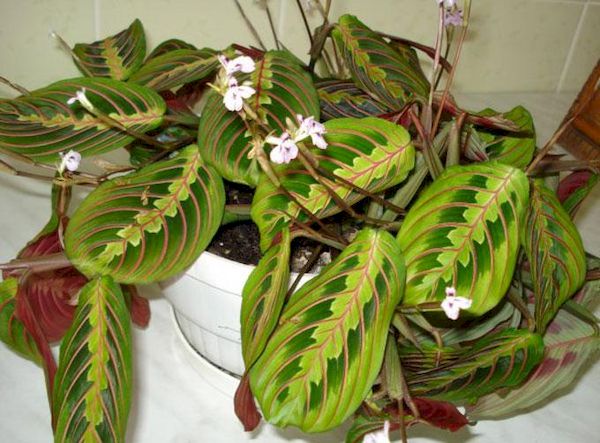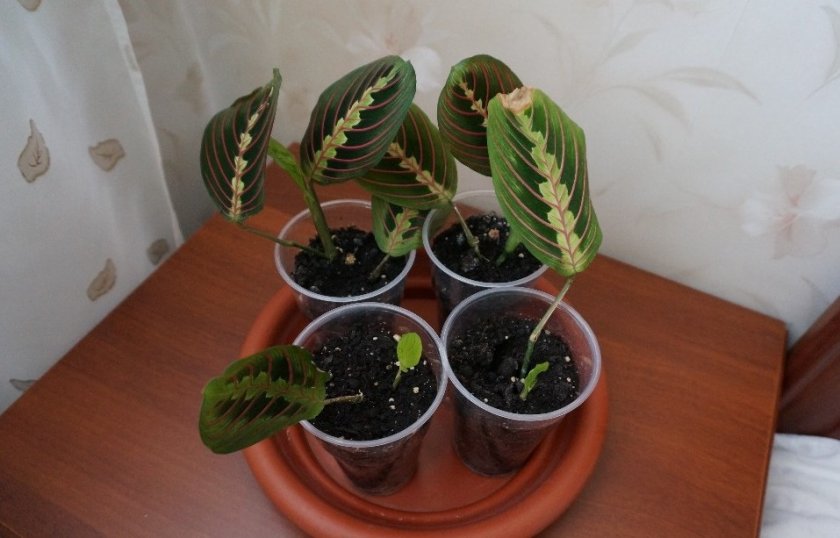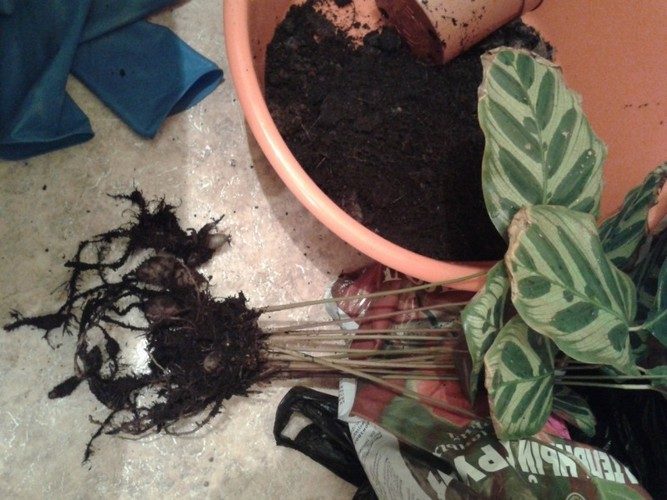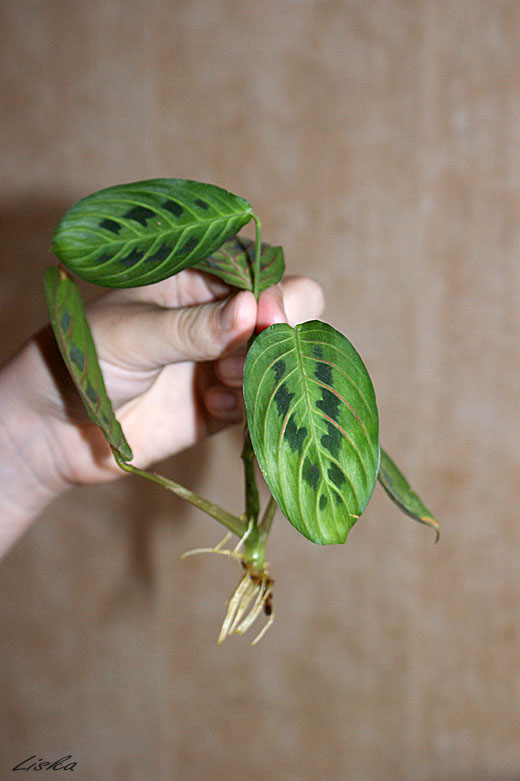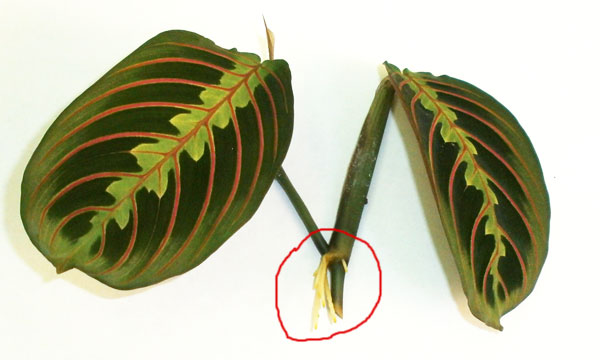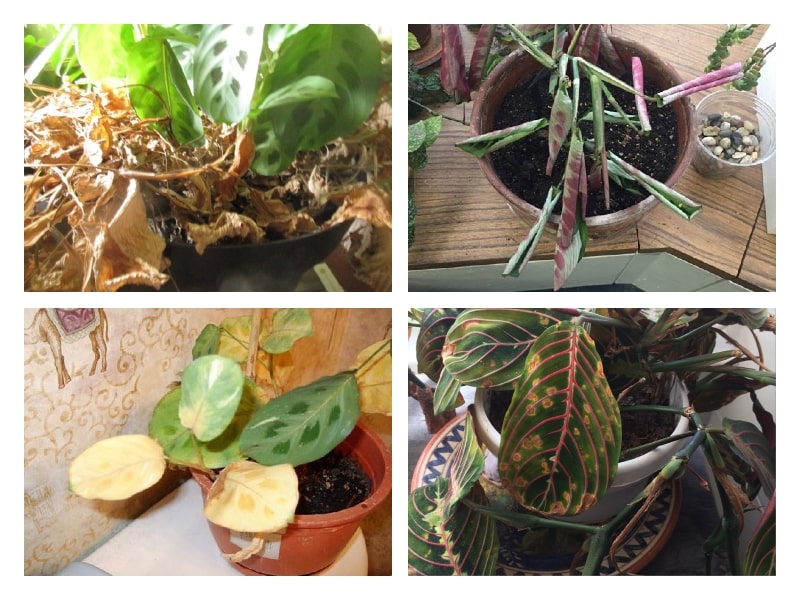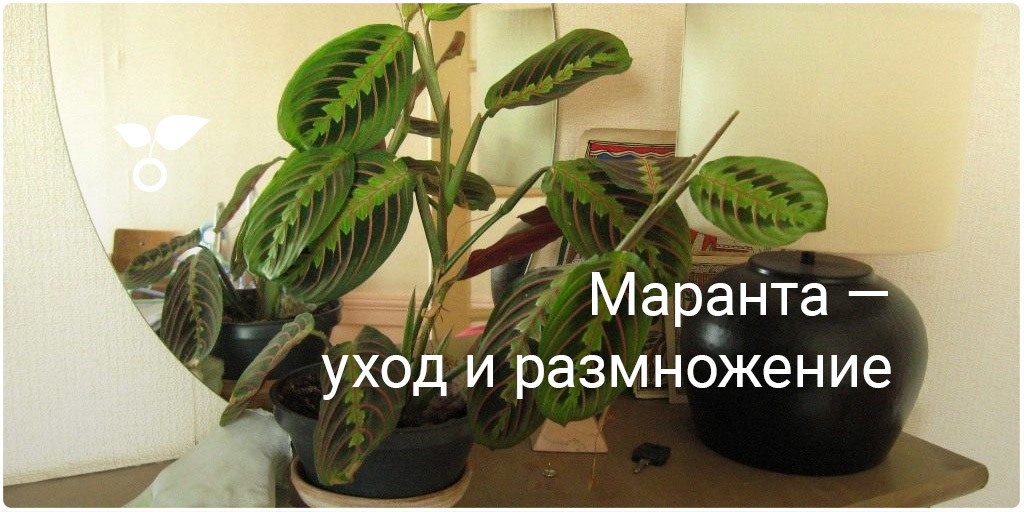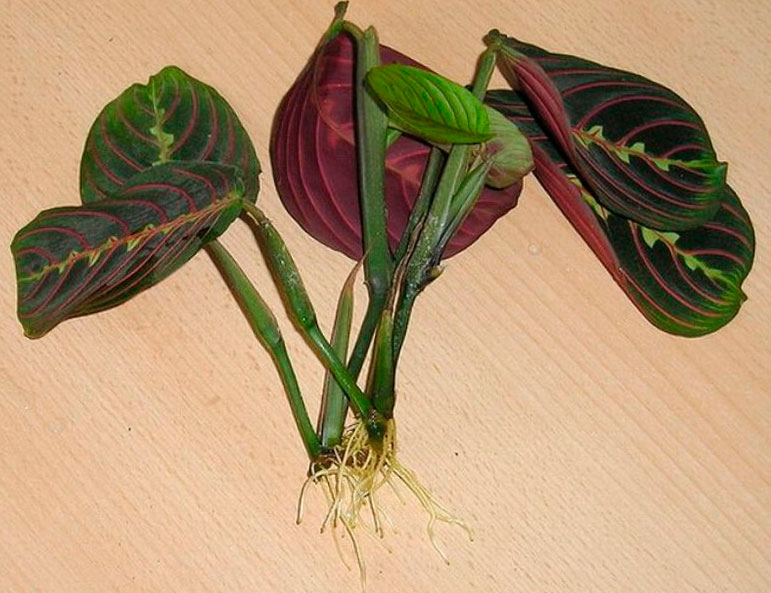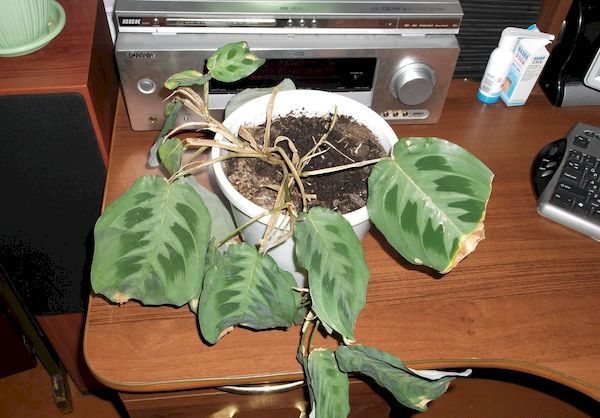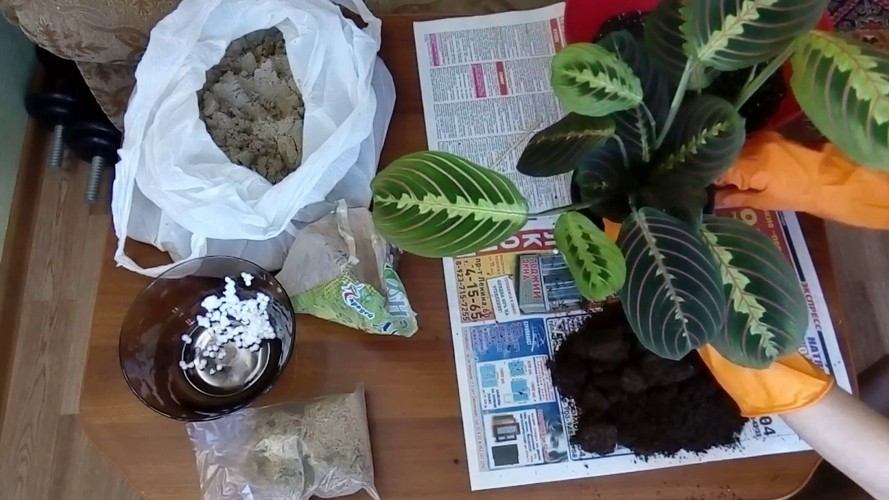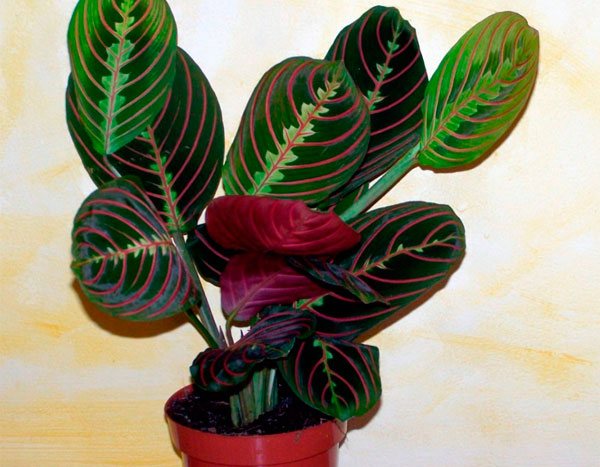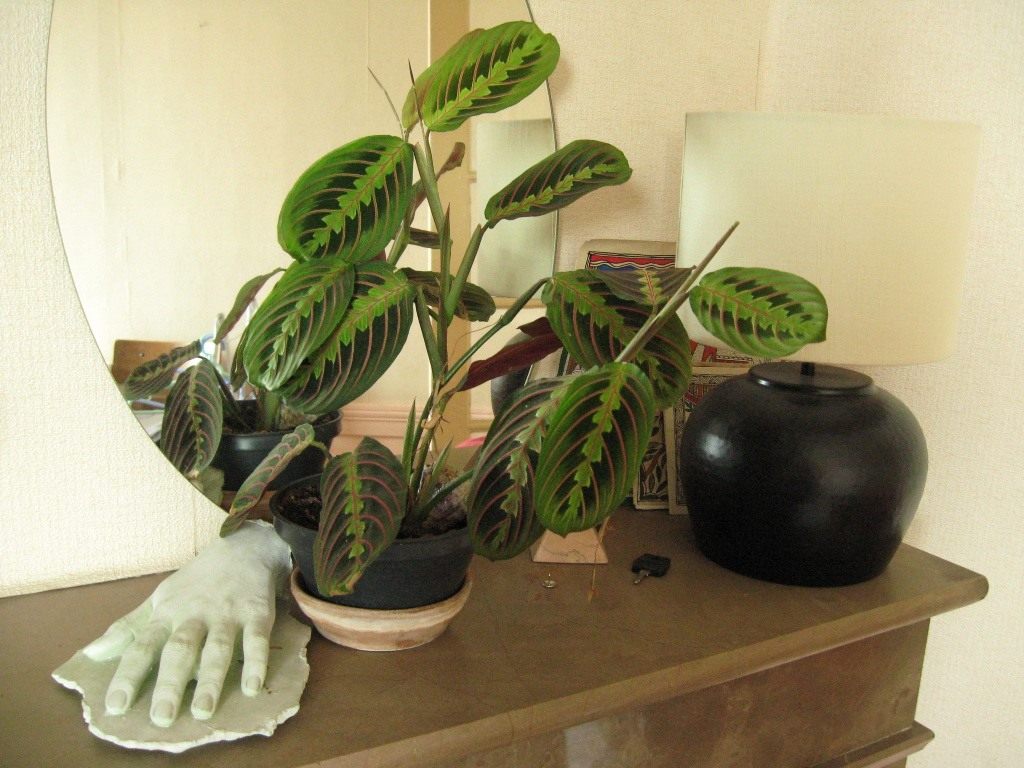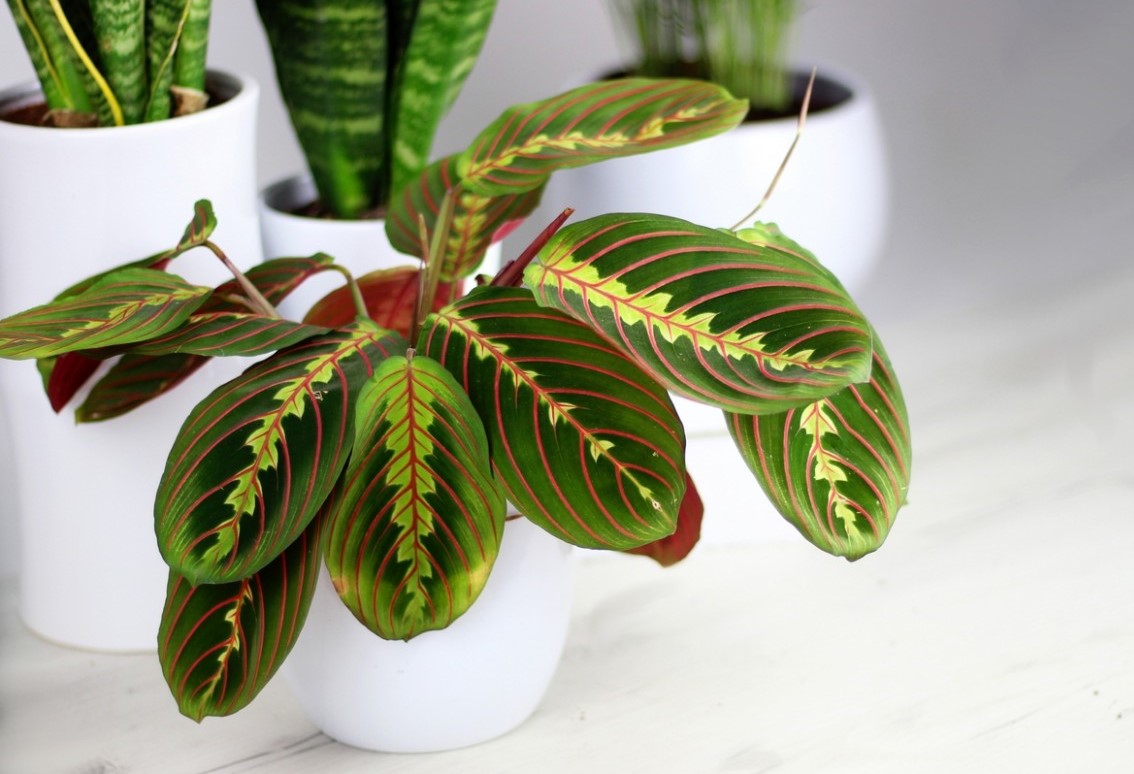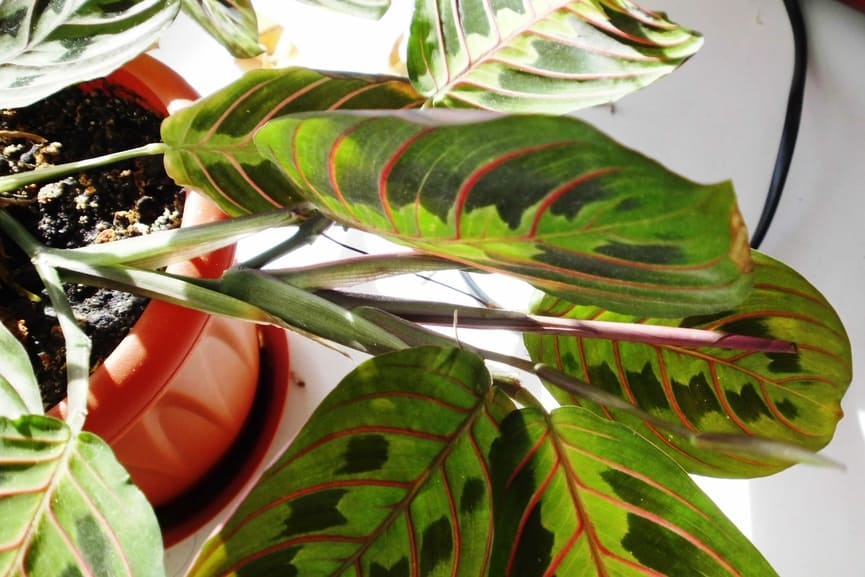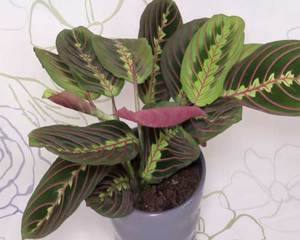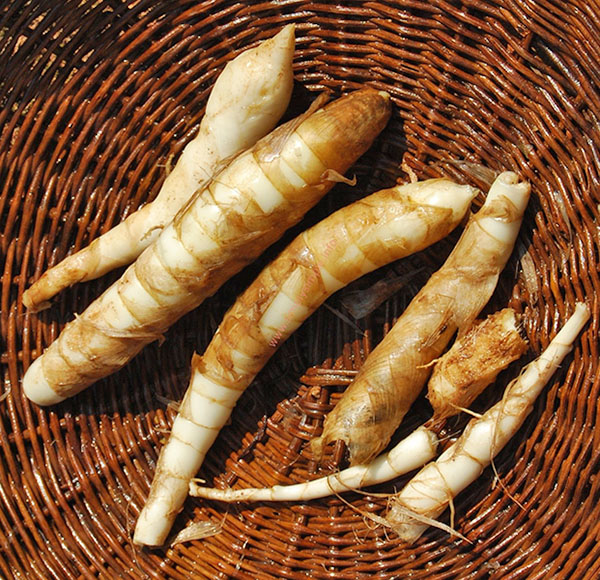Watering arrowroot correctly
The plant does not need regular watering. To determine when water is needed, it is worth looking at the condition of the soil. Naturally, in summer the earth dries out faster, so the flower needs water more often. Arrowroot tricolor is especially fond of moisture.
With the arrival of cold weather, it is necessary to limit the amount of moisture, and reduce the frequency of watering to 2 times a week. Watering can be alternated with spraying, which the arrowroot likes so much. The plant loves soft water, so do not use tap water immediately, but leave it for 24 hours. Boiled or melted water will also "taste" the flower.
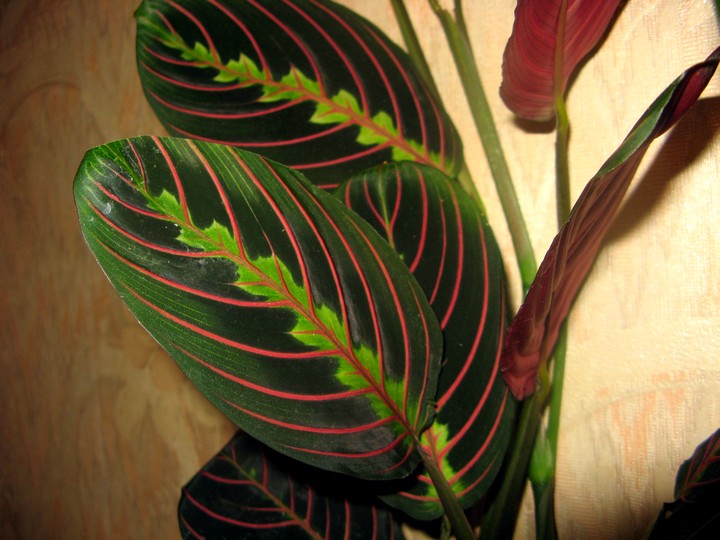
Humidity
Arrowroot is very demanding on the state of the air, so its humidity must always be maintained at a high level. For these purposes, we need moss or moistened expanded clay, which is poured onto a pallet, and a pot is placed on top.
Related article: poinsettia sheds leaves what to do
If there is dry air around the flower, then you can help the plant by bathing it. When you do this, the soil must be covered with any moisture-proof material so that putrefactive processes do not begin due to excess moisture.
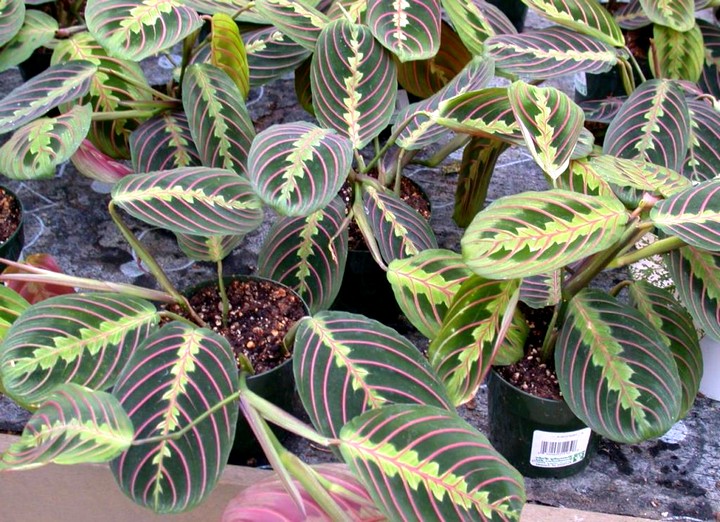
Top dressing
Often it is not worth pouring in fertilizers, but once every 2 weeks will be enough. The duration of top dressing is from the beginning of spring to the end of autumn. As fertilizers, it is recommended to use ready-made mixtures from the store, which must be properly prepared before applying to the soil. We dilute one gram of the purchased mixture in a liter of warm water and water the plants with this solution.

Types and varieties of home arrowroot: photos, names and descriptions of varieties

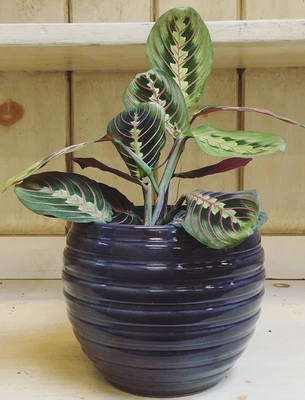
Each arrowroot is unique: different lighting affects the color of the leaves and their size. But the appearance of the exotic is largely determined by the species and varietal characteristics.
Among the types of amazing arrowroot, the most common are:
- White-veined.
- Kerhoven.
- Two-tone.
- Reed.
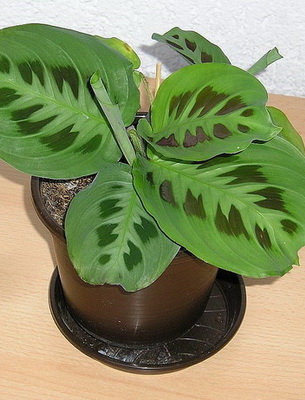
White-necked arrowroot is often found on the windowsills of experienced florists. Its height is 26-30 cm, the leaves are dark green, have silvery-white stripes in the center and on the lateral veins.
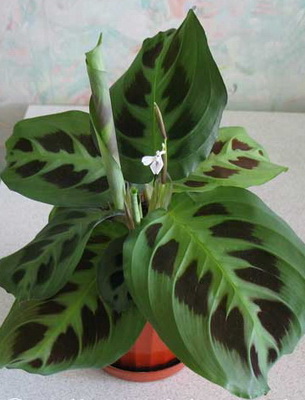
Among the types of "praying grass" a special place is occupied by a variety called the arrowroot Kerhoven. This inhabitant of the rainforest has a very bright color: on the outside of the leaf plate there are large dark green dots in the form of eyes and feathers, and in the center there is a white line that repeats the shape of the vein. Below the leaves are painted in a rich red shade with a blue overflow.
During flowering, Kerhoven's arrowroot forms small inflorescences of small white flowers. But professional growers still remove them with flower buds so that the plant does not waste energy. This type of exotic arrowroot is prized for its amazing leaves: thanks to them, it has become a very popular houseplant.
The red-veined (or tricolor) look combines three shades: dark green, light green and pale pink. The leaves are in the shape of an ellipse up to 6 cm wide. Their length does not exceed 13 cm, but this is enough to clearly see the amazing pattern on them. The leaf plates are dark green, but closer to the edge, this shade smoothly flows into a pale green. In the center are bright red-pink veins, the central one is marked with light speckled patterns. The plant can also be distinguished by its velvety leaves, which have a muted crimson hue underneath.
Look at the photo of these varieties of bright arrowroot with names to choose the best plant for indoor conditions:
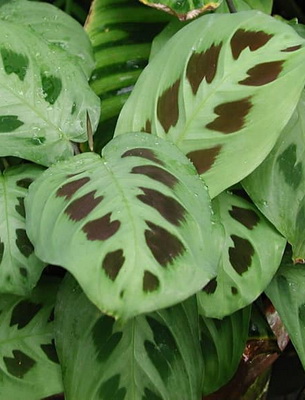
The bicolor appearance is characterized by an oval shape of leaves with wavy edges, the length of which varies from 10 to 15 cm.Their surface is smooth, but the petiole is slightly pubescent. The deciduous plate has an original pattern: along the central vein, two stripes of different shades of green alternate.
Take a look at the photo of this variety of arrowroot: the plant attracts attention with its unusual colors.
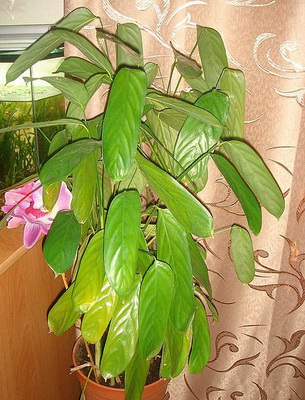
The reed species exceeds 1 m in height, and the leaves can reach a length of 25 cm. In the wild, it grows in South and Central America. The exotic has an exquisite color of the foliage: a dark green shade is in harmony with a grayish-gray. Flowers on reed arrowroot appear once a year: they are small in size, inconspicuous, have a white or cream shade. This arrowroot is rarely used as a houseplant due to its large size.
The Marantovaya family has amazing varieties with non-standard colors. For example, the white-veined species includes:
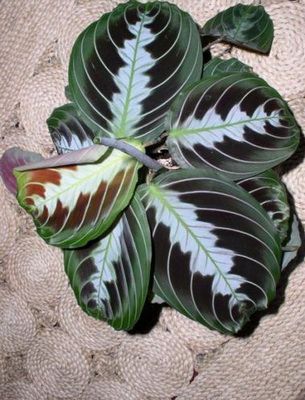
Maranta "Masanzha"
She is very gentle and demanding on the external environment, growing conditions.

Leaves of the "Massangeana" variety are distinguished by light central veins, from which thin graceful stripes radiate along the sides, and brown spots.
After reading the brief description, take a look at the photo of the Massangeana variety of the white-necked arrowroot species: it is easy to grow a resident of tropical forests at home.
In other exotic varieties, large elongated-oval leaves with interesting patterns also develop from folded leaf sheaths:
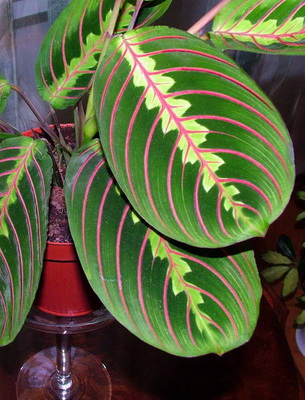
The Erithroneura variety has bright red leaf veins and a purplish red underside of the leaf.
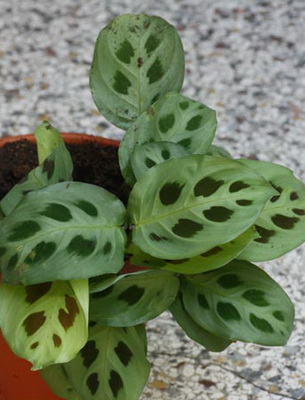
The "Kerchoviana" variety has emerald green leaves, a dark green-brown pattern.
The undoubted advantage of "praying grass" is that you do not need to wait for the flowering period, like most exotic plants, to enjoy its beauty. The extraordinary leaves look spectacular at any time of the year, and it is also interesting to watch them rise in the evening and return to a horizontal position in the morning.
Take a look at the photo of this: arrowroot can be viewed for a long time, admiring the color and texture of the leaves.
Reproduction of arrowroot
The main methods of propagation of arrowroot are dividing the bush or cuttings.
By dividing
-
When replanting, remove the plant and divide it into 2 or 3 parts.
- Each part should have a growing point and roots.
- Sprinkle the cuts with crushed coal, let dry.
- Plant in a mixture of earth (as when transplanting) and sprinkle with warm water.
-
Place the pot in a bag and tie it to create a greenhouse effect (the temperature in such a mini-greenhouse should be at least 20 ° C). Ventilate and water periodically.
- When new stems with leaves appear, remove the film and care as usual.
Cuttings
- Cuttings can be cut from May to September. These are the tops of shoots 10 cm long with 2-3 leaves and 2 internodes. The cut should be 2 cm below the knot.
- Put in water.
-
Roots will appear in 5-6 weeks.
-
Cuttings with roots can be planted in the ground, as well as during reproduction by division, creating a mini-greenhouse.
Table: Potential Problems and Solutions
| Problem | Cause | Solution |
| Arrowroot does not grow | Not enough moisture | Adjust the mode of watering and spraying |
| The flower dries up, the leaves are covered with brown spots | Lack of fertilizer, insufficient watering, low air humidity, improper soil composition | Feed, adjust the mode of irrigation and spraying |
| Leaves fade | Too much light | Provide the plant with partial shade |
| Leaves dry at the tips and turn yellow | Insufficient air humidity, drafts | Spray more often, protect from drafts |
| The stems and leaves wither and rot | Too much watering at low temperatures | Move the plant to a warmer place |
| Leaves curl, fall | Air is too dry | Spray more often |
Features of cuttings
For such a fragile plant as arrowroot, the method of propagation by cuttings is more gentle than the method of dividing the bush. In this case, it is not necessary to subject the adult plant to severe stress.Novice growers call this method "leaf propagation". This is not so, because it is not a leaf that acts as a cutting, but a cut off part of a young shoot.
Selecting and cutting cuttings
It is better to propagate arrowroot by cuttings in spring or early summer, that is, in May-June. If the procedure is done at a later date, the plant may not take root. Using a sharp knife, cut off a part of the shoot 8-10 cm long. There should be 4-5 leaves on the handle. The shoot should be cut below the knot, at a slight angle. Thus, you will increase the area for moisture absorption and root formation.
If circumstances do not allow you to immediately place the cutting in water, cut off the shoot longer and wrap it in a damp cloth. Before planting, refresh the cuts a little, but you should not delay with the procedure.
Rooting
The stalk can be rooted in water. Partially cut off the leaves and place the cuttings in a glass with settled water. It is not forbidden to plant the planting material immediately into a container filled with sand and peat soil. In this case, do not forget to moisten the soil with the cuttings planted in it.
Pots with future bushes need to be removed to a bright, but protected from the merciless sun rays. It is advisable to cover cups with landings with foil. This will provide the cuttings with greenhouse conditions. The comfortable rooting temperature is 23-25 ° C. The first roots will appear in 30-40 days.
Landing in the ground
When the cuttings grow roots and release fresh leaves, plant them in pots with prepared soil. The soil must be prepared from equal parts of garden and leafy soil with the addition of sand and peat. Remember to make good drainage from rubble or brick chips. Water the young plants with standing water at room temperature.
Place the young bushes near the west or east window. Arrowroot does not tolerate direct sunlight, but a lack of lighting will have a bad effect on the color of the plant. Elegant leaves will fade and lose their attractive appearance.
Diseases and pests
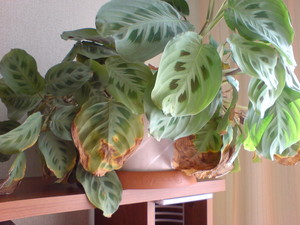 Despite the name - a prayer flower and its healing power and miraculous properties, the plant is prone to diseases. If you notice that arrowroot growth has slowed down, the leaves have begun to turn yellow, and their tips have become dry and brown, then the reason is most likely a lack of moisture, and the air in the room is too dry.
Despite the name - a prayer flower and its healing power and miraculous properties, the plant is prone to diseases. If you notice that arrowroot growth has slowed down, the leaves have begun to turn yellow, and their tips have become dry and brown, then the reason is most likely a lack of moisture, and the air in the room is too dry.
The correct solution to this problem would be to increase the humidity of the air by frequently spraying the flower. And also the plant can be put together with a pot in wet peat or in a tray with water and pebbles.
Dry air is the main reason why the leaves of a houseplant begin to curl and fall off. And also a spider mite can attack the plant if the air humidity is too low. A spider mite is a small "spider" of red color, almost invisible if you don't look closely at it.
The parasite appears on the lower part of the leaves and envelops the plant with white thin cobwebs. You can get rid of it by washing or spraying the leaves, mainly from the lower side.
And also a weak tobacco infusion with soap will show itself well in the fight against the pest, which must be thoroughly washed with the plant. Pollination of a flower with ground sulfur in the fresh air or using special preparations is also a good option for getting rid of arrowroot from spider mites.
After processing the plant, it is necessary to wash it well with cool water about a few hours after the procedure. It may be necessary to carry out the treatment several times until all pests are destroyed. In order to avoid damage to the plant by a spider mite, it is necessary to keep the flower clean, to spray it in a timely manner and not to put the pot near the radiators.
Diseases for arrowroot are inevitable in the following cases:
- If you keep the plant cold.
- Watering the flower too vigorously.
- Do not monitor the humidity of the air.
- Neglect the cleanliness of the premises.
If you do not urgently change the conditions in which the prayer flower is contained, then at first the leaves and stems will begin to fade and rot, and then the plant will die altogether. Arrowroots are very capricious to the light regime. Leaves can lose their color under too bright and intense light.
Leaves can easily burn if exposed to direct sunlight. The light for arrowroot should be diffused. If you can't find an alternative place in the house, then the best option would be to shade the flower using a special mesh or agrofiber.
Transfer
Young specimens of arrowroot need a transplant every year, and adults every 3-4 years. It is better to do this after pruning, when all the shoots are cut. It is necessary to take a pot for arrowroot, plastic or clay, covered with glaze, 2-3 cm larger than the previous one. Drainage in the form of pebbles or expanded clay, as well as holes for water drainage are required.
The soil for arrowroot should be loose, soft and light. You can buy ready-made soil for arrowroot in the store, or you can prepare the soil mixture yourself. To do this, use the following ingredients:
- 3 pieces of leafy land;
- 1.5 parts of peat;
- 1 part of coniferous land, sand and dry mullein;
- 0.3 parts of ash.
The transplant is carried out by transferring an earthen clod from one pot to another. For quick rooting and moisture retention, the pot can be temporarily covered with plastic. In the first month after transplanting arrowroot, you do not need to fertilize.
How to grow arrowroot at home: how to care for a plant during dormancy and flowering
At home, caring for an arrowroot flower is not so difficult - the plant is not very demanding, and in order to provide it with the necessary environmental conditions, you do not need to make much effort.
The flower needs bright light with shade from direct sunlight. Exposure to the sun is bad for this plant, so the arrowroot will begin to curl the leaves, which can confuse its owner. The best place for her is north, east or west windows.
In winter, arrowroot as a houseplant is no different from most other house flowers - it needs additional lighting with fluorescent lamps. Otherwise, the shoots will begin to stretch, and the leaves will shrink, which will ruin their decorative appearance. Too much light can negatively affect the color of the leaves - they get a pale shade. This may also be the reason why the arrowroot turns yellow, since the plant tolerates a slightly shady habitat much better.
Arrowroot is moderately thermophilic, it must be protected from drafts, otherwise the leaves will begin to dry. Dislikes sudden temperature changes. In the warm season, the flower will feel best at 20 - 25 ºC. In autumn and winter, the temperature should be reduced to 18 - 23 degrees. If it falls below 12 degrees, the flower may die. In winter, the room temperature should be at least 18 ° C. The soil in the pot should never dry out.
Do not put this plant pot on a cold floor or windowsill. If weather conditions permit, arrowroot can be taken outside, but it is necessary to find the right location - without drafts and direct sunlight.
This flower feels good in moderate humidity. If the air in the room is very dry, the plant should be sprayed frequently. In addition to spraying, there are several other ways to increase the moisture around the arrowroot. You can put the pot on a pallet with wet pebbles or expanded clay. But the roots should not be allowed to touch the filling.
You can also simply place a small container of water near the flower. On days when the air temperature rises above normal, the plant must be gently rinsed under the shower
It is important to cover the soil with plastic before this procedure.If the air in the house is too dry, the pattern will cease to be distinct, the leaves will lose their tone, and their tips will begin to die off.
Before you start caring for arrowroot, you need to remember that home conditions are not entirely natural for her, and in her native lands she lives in wet areas near water bodies, in wetlands. Therefore, it is desirable to bring the conditions of its growth closer to natural ones. To do this, use the tips below.
As you could already understand, this plant loves moisture. During the period of growth and development (spring and summer), arrowroot needs abundant watering. It is better to cover the soil in a pot with damp moss. With insufficient watering, the flower wilts and can dry out completely. However, excess moisture is also very harmful - it can lead to rotting of the root system. A particularly high probability of such an outcome appears at low air temperatures and heavy soil.
In winter, watering should be moderate. It is better to use water at room temperature. It is imperative to make sure that water does not fall on the leaves when watering, as this will lead to the appearance of fungi.
In the warm season, every two weeks, arrowroot should be fed with flower fertilizers, the concentration of which should be two times lower than indicated on the package. It is best to have a fertilizer nutrient ratio (NPK) of 3: 1: 2. If in the winter season the temperature and light conditions remain optimal, the plant must be fed once a month. However, if the plant is dormant, feeding is not necessary.
Flowering is not the main advantage of arrowroot, therefore, often only the bud that has appeared is cut off so as not to tire the plant once again. However, at home, this genus rarely blooms, so this is a whole event for some growers.
Features of the content
Arrowroot loves humidity and moderate light, without direct exposure to sunlight. A burn can also occur from touching the cold surface of a window in winter. Leaves raised in prayer composition speak of problems. The foliage of a healthy plant is open and slightly drooping.
Temperature and humidity
The optimum temperature for keeping arrowroot in summer ranges from 23-25 ° C, in winter it should not drop below + 12 ° C. It is advisable to keep the soil temperature at least +18 C. In the second half of autumn, a dormant period begins for the plant, until the end of spring, it is recommended to maintain a temperature of 18-20 C indoors. In nature, the plant lives in a humid tropical forest, protected from winds and aggressive sunlight. crowns of trees. It is possible to achieve close to natural conditions by humidifying the air in the room. The pot with the plant is placed on a tray with water, adding it as it evaporates.
Illumination
Needs good lighting, but no direct exposure to the sun. Feels comfortable on windows oriented to the west or east. With the condition of additional lighting, you can place arrowroot on the northern windows.
Pruning
Pruning, as a mandatory maintenance procedure, allows you to improve the overall appearance of the plant, and is also carried out for sanitary purposes.
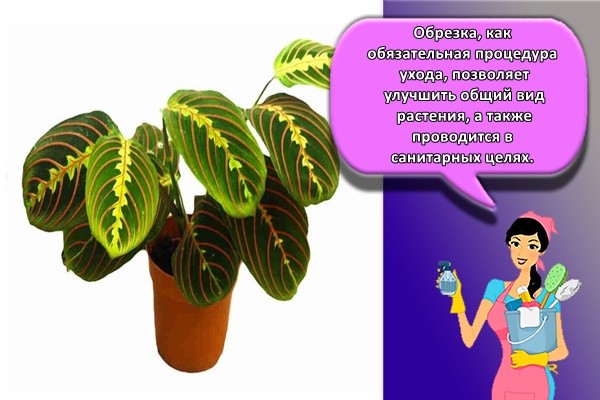
Formative
To obtain a dense bush, formative pruning stimulates the growth of lateral axillary buds. Regular pruning is carried out at the level of 3 internodes from the ground — the main stem (stems) and 3-4 nodes on the cuttings.
Sanitary
Dried leaves and plant parts damaged by disease must be removed. When most of the plant loses its decorative effect, it is cut off dramatically, at the root. To stimulate the germination of new shoots, the bush is placed in a dark room, they continue to be watered regularly. The plant needs 1.5-2 months to build up green mass.
Watering mode
During the growing season, the plant needs abundant watering, it should be guided by the drying of the top layer of the soil. During the rest period, watering is reduced.The soil in the pot should be moist, but without excess. Arrowroot roots are sensitive to stagnant water. For irrigation, use boiled, rain or settled water.
Spray
To maintain the optimal level of humidity in the room, it is necessary to irrigate the aerial part of the arrowroot at least 2-3 times a week. Spraying is also carried out for prophylaxis against pests.
Ventilation
Air circulation is necessary for the plant, while it categorically does not tolerate drafts and sudden temperature fluctuations. In some cases, it is preferable to sacrifice lighting than to lose the plant from being surrounded by a cold window and drafts.
Arrowroot prefers to grow upward, even after pruning it bushes a little. An adult plant in free growth can be tied to a support, or used in an ampelous version, then the leaves will hang on the sides of the pot. For the splendor of the bush, several plants are planted in one container.
Description of the plant and species
Arrowroot is a herbaceous low-growing perennial belonging to the Marantov family. Its homeland is the tropics of South America and Africa.
Arrowroot leaves are collected in a root rosette and have a wide-oval shape. The length does not exceed 15-25 cm. It is they that are of decorative value. The background color of the foliage, depending on the species and variety, varies from light to dark green, and bright veins, spots and stripes stand out on each leaf plate. Nondescript white, cream or light pink flowers are collected on a flower arrow in spike-shaped inflorescences. The arrowroot height does not exceed 30-40 cm.
About 25 species of arrowroot are known. Some of them:
- Arrowroot tricolor or tricolor - has large oval leaves, up to 15 cm long. Their background color is rich green. There are light green or beige spots near the central vein, and dark red spots are clearly visible along the side veins. The underside of the foliage is crimson.
- Arrowroot reed - has elongated leaves, up to 25 cm long. Light feathery spots are clearly visible along the central and lateral veins against a dark green background.
- Arrowroot arrowroot - has heart-shaped leaves, 11-15 cm long and up to 9 cm wide. The background is dark green, the veins are silvery-white, along them there are light green spots. The underside of the leaves is crimson or green in color.
How to care at home
Arrowroot belongs to the capricious indoor flowers.
Growing it is not easy - you need constant care and attention from the owner
It is important not to forget to water, fertilize, prune and replant it regularly. Even a short-term lack of care can negatively affect the beauty of the flower.
Even a short-term lack of care can negatively affect the beauty of the flower.
Watering
The flower prefers frequent and abundant moisture. The upper earth layer should not be allowed to dry out too much. In the summer, the indoor culture needs to be watered daily, but controlled so that there is no stagnation in the pot. In winter, the frequency of humidification should be reduced to 1 time in 5-7 days.

You only need to moisten the flower with warm water - a couple of degrees warmer than room temperature. The water should be settled within 2 days, filtered, melted or rainwater.
Top dressing
Like most indoor decorative leafy crops, arrowroot needs to be fertilized. In the growing phase - from spring to summer - 2 fertilization will be required per month. Organics, mineral fertilizers and universal fertilizers for decorative deciduous plants are suitable. The dosage indicated by the manufacturer is recommended to be halved. In winter, the frequency of feeding should be reduced to one per month.
Important! The use of a large number of nitrogen baits should be avoided - they change the color of the foliage.
Pruning
This is another indispensable procedure that is necessary to achieve the robust health of the plant and its stable beauty.In winter, the shoots can be very stretched and lengthened, as a result of which the plant will look sloppy. And such a procedure as pruning arrowroot, carried out regularly and in a timely manner, will allow you to form a lush bush, activate the formation of young shoots, get rid of sick and old branches and leaves.

Formative pruning is planned for February - March. Sanitary - carried out as needed. Disinfected sharp scissors remove strongly elongated, diseased, old shoots, dried, yellowed leaves.
Transfer
Until the flower reaches 3 years of age, it must be transplanted annually. In the future, you will need 1 update of the pot and soil in 2-3 years. The plant is transplanted in March.
Before replanting arrowroot, you should purchase a pot and soil. The shops sell soil "for decorative leafy plants", ideal for the cultivation of arrowroot. You can also mix the substrate with your own hands by combining the following ingredients:
- garden land (6 parts);
- peat (3 parts);
- sand (2 parts).
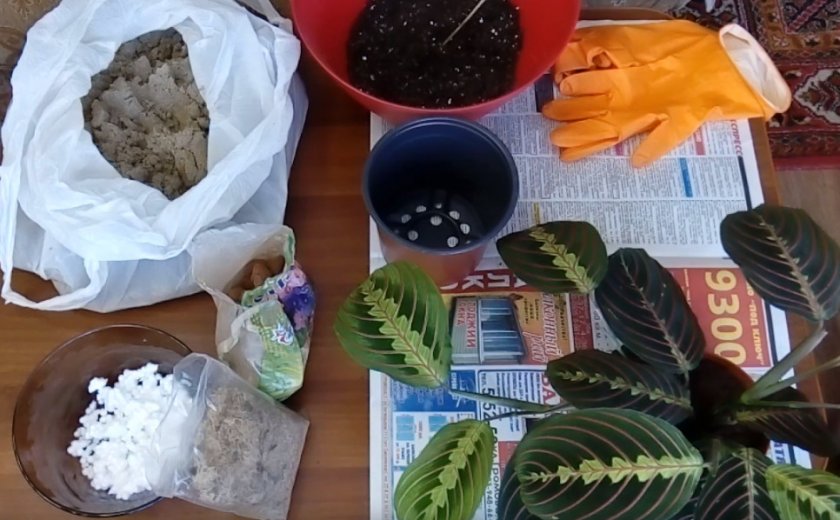
- leafy land;
- peat;
- humus.
The transplant is carried out by the transshipment method. For its successful implementation, the following steps are taken:
- At the bottom of the container, lay a drainage layer of expanded clay, pebbles, broken brick, coarse sand.
- Sprinkle the drainage with soil.
- Water the flower well.
- Inspect the plant and cut off dry, yellow leaves.
- Remove the flower from the pot along with the earthen lump.
- Move the earthen ball to a new container.
- Cover with soil.
- Moisturize liberally.
- Place in a warm, well-lit, but shaded place.
Reproduction methods
Reproduction by division
You can propagate arrowroot by dividing the rhizome. This procedure is recommended to be carried out in conjunction with a transplant. To get started, remove the adult plant from the pot and divide it into 2 or 3 parts, while trying not to injure the root system. Delenki are planted in separate pots filled with peat. Young bushes are watered regularly immediately after the surface of the soil mixture in the container dries out. The container with the divider is placed in a plastic bag, which is not tied very tightly. Keep it warm until young leaf plates appear.
Cuttings
Cuttings are harvested in May-June, for this they cut off a part of the young shoot, on which there should be 2 or 3 leaf plates. To root the segments, use a jar filled with clean water, the roots should appear after 4-6 weeks. The rooted cutting is planted in a peat-based soil mixture and provides it with the best possible care.
Reproduction of arrowroot
The best way to get a new plant is to propagate the arrowroot by dividing the bush at the right time for replanting. The separated parts of the plant are planted in small pots with soil, prepared as described above.
To root the separated parts of the plant, the pots are covered with foil and kept in a warm place. It is desirable that during this period the air temperature is not lower than +20 degrees. When the plants take root and start growing, the film can be removed and further looked after, as mentioned above. Usually, if these conditions are met, rooting of arrowroot takes place without problems.
You can propagate arrowroot with apical cuttings. To do this, in late spring or summer, cuttings with 2-3 leaves from new shoots of the plant must be cut and placed in water. Arrowroot cuttings take root in about five to six weeks. They take root well in greenhouses with high temperature and humidity. The cuttings that have given roots are planted in a peat-based planting substrate.
 Arrowroot reed, also real arrowroot, or West Indian (Maranta arundinacea). Nobis85
Arrowroot reed, also real arrowroot, or West Indian (Maranta arundinacea). Nobis85
Main varieties
The arrowroot family has only 25 varieties. Only a few of them can be grown at home. Here are some common types of ampelous plants:
- Reed arrowroot.Tall (up to 1.3 m), but rather compact plant that has tuberous thick roots. The leaves are slightly elongated, dark green with a bluish tinge. They resemble an egg with a sharp top. Below, the leaves are slightly pubescent. Small white flowers.
- White-streaked arrowroot. Perhaps the most common plant of the arrowroot. The leaves are gray-green with silvery veins. The stem is rather short (up to 30 cm). The leaves are heart-shaped (length from 11 to 15 cm), from below they can be bluish-green or reddish. The root system of this plant species is tuberous. The flower is quite unpretentious to care for and multiplies well at home.
- Arrowroot gibba. You can meet such a specimen most often in Mexico, on the island of Trinidad, as well as in South and Central America. The leaves of the plant are ovoid, while the inflorescences are collected in a so-called panicle.
- Arrowroot massage. The indoor flower has characteristic dark spots on the leaves (from black to olive-brown) and a central light stripe. The plant looks very compact. If we compare the arrowroot massage with other types, then it is considered the most undemanding to care for.
- Maranta Kerhoven. The flower has oval leaves, which are located on short stalks, and small white flowers. Below, the leaves can be colored red or bluish. The top is decorated with a light central stripe and ocellated or feather-like specks of a dark green hue. This species is considered very hardy, so you can even find such a plant at novice gardeners.
- Tricolor arrowroot. A very spectacular and unusual variety. The saturated background of its leaves is represented by a tricolor, which fades as it approaches the edge. This color mix looks very impressive. Light green or yellowish spots are located along the red central vein. On the edges of the leaves are feather-like patterns of dark color. On the inside of the sheets, red streaks are clearly visible, which fade over time and acquire a pink tint. It is rather difficult to explain why the tricolor arrowroot is compared to fish, but sometimes it is called the “red herring ridge”.
- Bicolor arrowroot. If you look at this representative from a biological point of view, it will be very similar to the Kerhoven arrowroot. On a relatively small petiole there are oval leaves of a reddish hue, which reach a length of 11-15 cm and have slightly wavy edges. From below they are slightly pubescent; a reddish ornament is also visible here. The upper leaf pattern is represented by rich brown and green specks. This type of arrowroot does not form tubers.
Why do arrowroot leaves curl and dry and what to do to treat diseases
For example, often novice growers wonder why arrowroot leaves curl and how to prevent it. The reason, most likely, will be too bright lighting or even direct sunlight on the flower, which is completely contraindicated.
Also, do not confuse with diseases the characteristic feature of this plant to behave this way at nightfall. It is necessary to sound the alarm if, despite the fact that the leaves of the arrowroot curl, they also begin to dry from the edges.
This indicates that the soil is not sufficiently moistened, or the temperature in the room is too low. In any case, the reason must be sought in flower care. All you need to do if arrowroot leaves continue to curl is to find out the cause and eliminate it.
If the soil is regularly moistened normally, then the plant must be moved to a warmer place. It is possible to find out that the reason for such changes was insufficient watering, if, with the above symptoms, brown spots appear on the leaves.In rare cases, foliage can coagulate in conditions of too dry air. In this case, you can save the situation with spraying and mineral fertilizers.
It is also not uncommon for arrowroot leaves to dry out, but not everyone knows why this happens, making mistakes in attempts to somehow correct the situation.
In this case, you need to pay attention to how exactly the drying takes place.
With the help of fertilizers, you can treat arrowroot if the disease spreads from the edges, and then manifests itself as brown spots all over the leaf area. Low air humidity leads to the same result. If, at the same time, the lower leaves of arrowroot also turn yellow, we can definitely say that the cause of the disease lies in improper watering and an insufficient amount of water procedures. An unexpected, but quite likely reason may be the presence of lime in the soil, so it is imperative to check the soil indicators.
There may be many reasons why arrowroot leaves began to turn yellow, so you need to look for other factors as well that would help answer this question. The fact is that most plants react to any stress by changing the color and texture of the leaf surface.
Cold indoor air can be one of the main reasons. This flower does not tolerate rapid temperature changes. Direct sunlight will cause yellow burns on the leaves. Drafts can also cause these changes in plant appearance.

